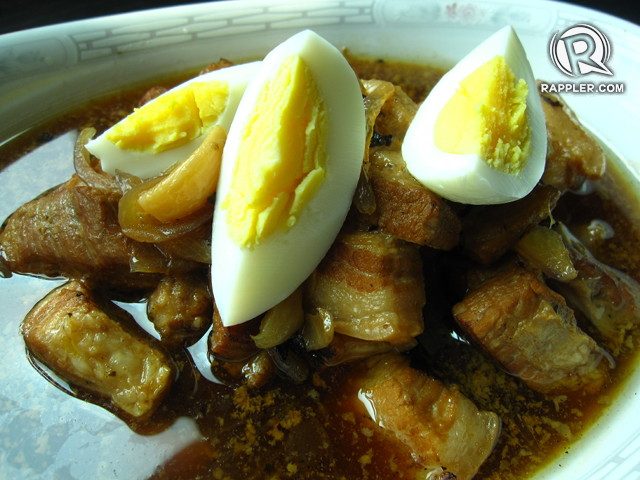SUMMARY
This is AI generated summarization, which may have errors. For context, always refer to the full article.

PARIS, France – Did the Philippine national dish originate in France?
I’m more than ever convinced that the stew of meat swimming in its own juice and oil with spices is actually French food. To be precise, food prepared in a distinctly French technique with an undeniable Filipino accent.
That marriage of pork, beef, chicken, squid, or kangkong (morning glory) with bay leaves, pepper, garlic, soy sauce, and vinegar represents the complex Philippine palate and culture.
Many have declared the dish “indigenous” to the archipelago, but is it really?
Some experts attribute adobo‘s landing in the Philippines to Mexico by way of the Galleon Trade. Yes, the southern third of North America boasts of as many adobo recipes as its national dish, the mole (moh-leh). But countries further down in South America, too, have their own interpretation of the dish, betraying its source – the nation that unified a continent with a common religion, language and well, a viand.
Authorities concur that Spain is the mother of adobo, evidenced by its definition of adobar or to marinade. Its Iberian neighbor Portugal has its own version.
No food blogger has challenged the broadly accepted belief that Spain is the origin of adobo. But hungrier, perhaps wider traveled, gastrogeeks ventureed further into the etymology of the subject. And deeper digging unearthed a French connection.
Here I am, Parisienne-for-the-weekend, watching diners dig into their plat, or what we in the U.S. call “entree” (which is “starter” in France).
When the French slow-cook or braise budget meats in herbs, they call it en daube. Say it as Catherine Deneuve would, with a silent “n” and an audible “e”: “E’ dob-e.” Now faster: “Uh-duhb’uh.”
Shared borders, recipes
Because France shares a border with Spain, their recipes intermingle.
Bouillabaisse, a symphony of seafood that’s favored in the south of France port city of Marseille is almost identical to Zarzuela de Mariscos, the Catalan seafood stew. The French have garlicky mayonnaise with a touch of mustard called aioli and the Spanish hold the mustard and call theirs allioli. Nougat, a Provençal delicacy showcasing the region’s almonds, bares little difference from Torrones de Almendras in northern Spain.
Daube is emblematic of Rhone River-fed Provence, fabled region in the south of France where the warmer climate and the rich terroir – or natural elements – heighten scents and flavors of all that grow there. The conquering Romans loved the landscape and dubbed it provincia. They reveled in its natural gifts, including an herb they named lavandula with which they perfumed their laundry and that we now stuff in sachets with our lingerie.
Garlic, eggplant, peppers, tomatoes, and herbs thrive wild next to fields of that intoxicating lavender, olive groves and vineyards that produce the famous Cotes du Rhone and the venerable Chateauneuf-du-Pape (new castle of the pope) around Avignon, site of the papal seat when the French monarchy and the Catholic hierarchy could not see eye to eye in the 14th century.
Herbs are so intense they elevate the lowliest ingredient to “gourmet” status beyond the land where American culinary icon Julia Child wished she had been born. Think snails, sold only in upscale stores in the United States, and are considered vermin in gardens surrounding both huts and mansions in the Philippines.
The south of France has its own bullfights but not bloody as those typical in Spain. The French merely tease the beast but do not impale it to death. When the animal is past its prime and unfit for pasture, it retires in the kitchen. Bathed and simmered for hours in wine, olive oil, and aromatics, the bull reincarnates into a dish that is a feast for the senses.
Julia Child describes the technique in Mastering the Art of French Cooking, her 1961 tome that changed the way Americans eat: “Daube comes from daubiere, a covered casserole. Almost every region of France has its own daubes, estouffades and terrine.”
Child adds a ”variation” popular in Provencal that punches up the flavor with achovies, capers and – guess what – vinegar!
Cross culture
As the beloved chef said, a special cookware named for the dish, the “daubiere” is shaped to build condensation, prevent evaporation, and seal in all the juices.
Purists say daube should be marinated first then cooked at least a day before and allowed to rest before serving. The longer the simmer, the better the taste.
Sound familiar?
The recipe has morphed over time and geographic boundaries, like everything else particularly in this global society.
Don’t forget that the likes of those who invented Champagne also Christianized most of the world. Their brother missionaries may have brought along their daubiere and taught “en-daube” to their indigenous wards, who procured native ingredients to replicate the original.
Highly probable: Replaced the bell peppers with bay leaves, substituted vinegar for the wine and soy sauce for the olive oil, doubled the garlic and developed what is now the Philippine national dish.
Of course Philippine adobo is only as “authentic” as the region that serves it. Coconut cream enriches the southern Luzon variety. Pineapple and sugar jazz it up in Central Luzon. Filipino Hawaiians spike up theirs with ginger.
Daube transformed similarly.
New Orleans serves a jellied stew called Daube Glacé. Other recipes eschew the Frenchy orange zest and cinnamon peel, throwing in carrots and mushrooms instead. The daubiere? Usurped by a Dutch oven or a heavy lidded pan that performs like the French pot.
And the palayok (clay pot) comes to mind. – Rappler.com
Essay is updated from original first published in Philippine News and received First Prize for Food in the 2014 Plaridel Awards for Excellence in Journalism.
Send your thoughts and Adobo recipes to author.
Add a comment
How does this make you feel?





There are no comments yet. Add your comment to start the conversation.